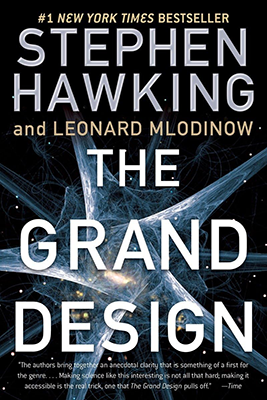The Grand Design
“The Grand Design” by Stephen Hawking and Leonard Mlodinow is a groundbreaking exploration of the fundamental questions of existence, including the origin of the universe and the nature of reality. Here’s a summary:
Introduction to Modern Cosmology: Hawking and Mlodinow introduce the reader to the field of cosmology, the study of the origin, evolution, and ultimate fate of the universe. They discuss the Big Bang theory, inflation, and the evidence from observational astronomy that supports our current understanding of the universe.
The Quest for a Theory of Everything: The authors explore the search for a unified theory of physics, often referred to as a “theory of everything,” that would encompass all the fundamental forces of nature. They discuss the challenges of reconciling general relativity (which describes gravity) with quantum mechanics (which describes the behavior of particles at the smallest scales).
M-Theory and the Multiverse: Hawking and Mlodinow introduce M-theory, a theoretical framework that extends string theory and offers a potential candidate for a theory of everything. They discuss how M-theory suggests the existence of multiple universes, or a “multiverse,” each with its own physical laws and properties.
The Role of Laws of Nature: The authors explore the concept of “model-dependent realism,” which suggests that our perception of reality is shaped by the models or theories we use to describe it. They argue that there is no single “true” reality, but rather a range of possible descriptions of the universe, each governed by its own set of laws of nature.
The Anthropic Principle: Hawking and Mlodinow discuss the anthropic principle, which suggests that the laws of physics and the properties of the universe are finely tuned to allow for the existence of life. They explore various interpretations of the anthropic principle and its implications for our understanding of the universe.
Philosophical Implications: The authors reflect on the philosophical implications of modern cosmology, including questions about the nature of existence, the meaning of life, and the possibility of a creator or designer of the universe. They argue that science can provide answers to these questions without the need for supernatural explanations.
Conclusion: Hawking and Mlodinow conclude by emphasizing the importance of scientific inquiry and critical thinking in understanding the nature of reality. They argue that while there may be limits to our knowledge, science offers the best tools we have for exploring the mysteries of the universe.
Overall, “The Grand Design” offers a thought-provoking and accessible exploration of the origins and nature of the universe. Hawking and Mlodinow’s clear and engaging writing style, coupled with their deep understanding of modern cosmology, make the book a must-read for anyone interested in the big questions of existence.

